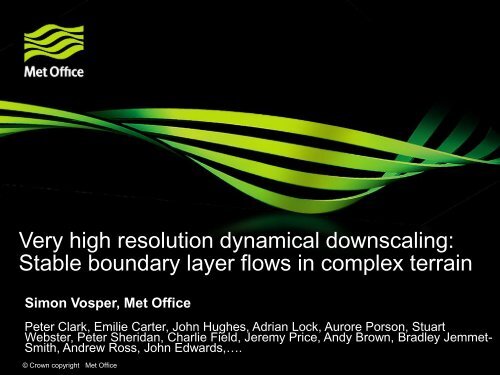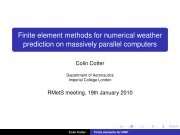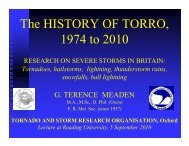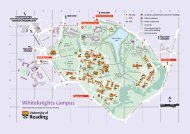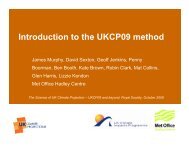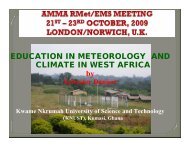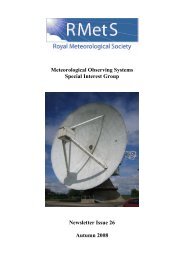Simon Vosper, Met Office
Simon Vosper, Met Office
Simon Vosper, Met Office
You also want an ePaper? Increase the reach of your titles
YUMPU automatically turns print PDFs into web optimized ePapers that Google loves.
Very high resolution dynamical downscaling:<br />
Stable boundary layer flows in complex terrain<br />
<strong>Simon</strong> <strong>Vosper</strong>, <strong>Met</strong> <strong>Office</strong><br />
Peter Clark, Emilie Carter, John Hughes, Adrian Lock, Aurore Porson, Stuart<br />
Webster, Peter Sheridan, Charlie Field, Jeremy Price, Andy Brown, Bradley Jemmet-<br />
Smith, Andrew Ross, John Edwards,….<br />
© Crown copyright <strong>Met</strong> <strong>Office</strong>
Background<br />
• Can modern NWP be used to reliably forecast variations on<br />
kilometre-scales or smaller?<br />
• How well can we expect to predict the local detail of wind,<br />
temperatures, or fog?<br />
• In complex terrain, the stable boundary layer can exhibit rapid<br />
spatial changes in wind, temperature and fog. Cold pools can<br />
form in valleys during clear-sky calm nights.<br />
• These are important for applications such as forecasting along<br />
a route (e.g. for gritting), pollution dispersion, crop exposure…<br />
© Crown copyright <strong>Met</strong> <strong>Office</strong>
IR imagery of the Clun Valley, Shropshire<br />
22nd September 2011, Duffryn, ~2000 UTC<br />
© Crown copyright <strong>Met</strong> <strong>Office</strong><br />
Thanks to Jeremy Price
Background<br />
• Even the finest resolution operational NWP models cannot<br />
resolve processes across ~1km hills and valleys.<br />
• Post-processing techniques are applied to correct raw model<br />
output. These rely on:<br />
• Statistical methods e.g. correct using nearby observations<br />
• Physically based techniques e.g. adjust air temperatures to<br />
account for errors in model orography height and unresolved<br />
processes<br />
• In the future, “dynamical downscaling” might become feasible<br />
for selected locations. This involves nesting very high-resolution<br />
grids within the NWP model to realistically predict the local<br />
detail of the flow.<br />
© Crown copyright <strong>Met</strong> <strong>Office</strong>
Questions<br />
Will focus on some high-resolution forecasts of flow and<br />
temperatures across complex terrain.<br />
Questions:<br />
• How do the model predictions improve as we go to higher<br />
resolution?<br />
• How does dynamical downscaling compare with simpler<br />
post-processing techniques?<br />
© Crown copyright <strong>Met</strong> <strong>Office</strong>
COLPEX Field Campaign<br />
COLd air Pooling EXperiment<br />
• Concerned with the formation of cold pools in<br />
valleys during stable night-time conditions.<br />
• Collaboration between <strong>Met</strong> <strong>Office</strong> and NCAS,<br />
involving the Univ. of Leeds, Salford and Surrey.<br />
• Clun Valley, Shropshire:<br />
• Rolling terrain ~200 m valley-summit, ~1 km<br />
wide<br />
• Ground network combined with upper-air and<br />
remote sensing measurements<br />
© Crown copyright <strong>Met</strong> <strong>Office</strong>
Location<br />
Clun valley<br />
© Crown copyright <strong>Met</strong> <strong>Office</strong><br />
Peter Clark
Instrument sites<br />
• 3 main mast<br />
sites<br />
• D=Duffryn<br />
• B=Burfield<br />
• S=Springhill<br />
• Instrumented<br />
transects<br />
• Radiosondes<br />
• Lidar<br />
• Instrumented<br />
vehicle<br />
2 km<br />
© Crown copyright <strong>Met</strong> <strong>Office</strong>
© Crown copyright <strong>Met</strong> <strong>Office</strong> Jeremy Price
Model configuration<br />
• Very high resolution simulations<br />
using the <strong>Met</strong> <strong>Office</strong> Unified Model<br />
• Nested from 4 km resolution domain<br />
to 1.5 km, and then 100 m model<br />
via a horizontally stretched grid<br />
• Enhanced vertical resolution: 12<br />
levels below 112 m vs 5 levels in<br />
operational model<br />
D=1.5km<br />
Stretching zone<br />
30 km<br />
Clun valley<br />
30 km<br />
D=100m<br />
© Crown copyright <strong>Met</strong> <strong>Office</strong><br />
(Peter Clark)
What does 100 m resolution give?<br />
Dx=100 m<br />
Dx=1.5 km<br />
© Crown copyright <strong>Met</strong> <strong>Office</strong><br />
Emilie Carter
9th September 2009 (IOP 4)<br />
Initial focus on the clear-sky COLPEX IOP<br />
Simulation from 15UTC 09 to 15 UTC 13 September 2009<br />
00 UTC 10/09/2009<br />
© Crown copyright <strong>Met</strong> <strong>Office</strong>
Potential temperature at 2m<br />
2009/09/09 1800 UTC 2009/09/09 1900 UTC<br />
© Crown copyright <strong>Met</strong> <strong>Office</strong>
Potential temperature at 2m<br />
2009/09/09 2000 1800 UTC 2009/09/09 2100 1900 UTC<br />
© Crown copyright <strong>Met</strong> <strong>Office</strong>
Potential temperature at 2m<br />
2009/09/09 2200 UTC 2009/09/09 2300 UTC<br />
© Crown copyright <strong>Met</strong> <strong>Office</strong>
North-South section through Upper Dyffryn, Clun Valley<br />
q ( o C)<br />
Dx=1.5 km<br />
Clearly © Crown 1.5km copyright resolution <strong>Met</strong> <strong>Office</strong> is inadequate!
Model screen temperature: D=100m L140 vs D=1.5km L70<br />
Duffryn<br />
Temperature<br />
minima well<br />
represented<br />
Daytime<br />
temperatures too<br />
cold<br />
Clear benefit<br />
of 100m<br />
resolution<br />
over 1.5km<br />
© Crown copyright <strong>Met</strong> <strong>Office</strong>
140-level 100 m model results<br />
Duffryn (Clun valley) Springhill (hill top) Burfield (valley)<br />
T( o C) T( o C)<br />
T( o C)<br />
-model<br />
-obs<br />
5<br />
Wind speed (ms -1 ) 8 Wind speed (ms -1 ) 8 Wind speed (ms -1 )<br />
0 © Crown copyright <strong>Met</strong> <strong>Office</strong><br />
0<br />
0
Cold pool strength<br />
• Repeatable nighttime<br />
DT of<br />
approx. -4 K<br />
• 100m L140 model<br />
gives good<br />
prediction of DT<br />
amplitude<br />
• Coarser vertical<br />
resolution (L70)<br />
results in weaker<br />
cold pools<br />
© Crown copyright <strong>Met</strong> <strong>Office</strong>
NWP temperature post-processing<br />
• A cheaper alternative to dynamical downscaling is to<br />
post-process the coarser (4 km) resolution predictions to<br />
account for the unresolved orography<br />
• Two-stage process:<br />
1. Perform correction for “smoothed” model height, based on local<br />
screen temperatures in UK4 (Sheridan et al. 2010) to determine<br />
an effective lapse rate.<br />
2. Additional “valley parametrization” accounts for cold pools in<br />
hollows (following <strong>Vosper</strong> & Brown 2008)<br />
• For each point, diagnose a local “valley depth”, H<br />
• Correction to temperature is a function of NH/U, where N and<br />
U are the buoyancy frequency and wind speed<br />
© Crown copyright <strong>Met</strong> <strong>Office</strong>
Post-processing<br />
10-11 Sep<br />
Observed<br />
4km model<br />
4km model + height correction<br />
4km model + height correction + valley parametrization<br />
•Need a hill parametrization?<br />
© Crown copyright <strong>Met</strong> <strong>Office</strong><br />
Peter Sheridan
Instrumented vehicle measurements<br />
10 Sept 2009 0520-0606<br />
Measured<br />
Post-processed<br />
© Crown copyright <strong>Met</strong> <strong>Office</strong><br />
Peter Sheridan
Post-processed<br />
Post-processed<br />
100m model vs<br />
post-processing<br />
• Post-processing fails<br />
to reproduce size of<br />
spatial variations:<br />
100m model<br />
100m model<br />
• 100m model hill<br />
tops are warmer<br />
• 100m model<br />
predicts interand<br />
intra- valley<br />
variability<br />
© Crown copyright <strong>Met</strong> <strong>Office</strong><br />
Peter Sheridan
Foggy case 10-11 Dec. 2009<br />
• Model predicts very<br />
detailed fog<br />
distribution<br />
• Fog forms at<br />
different times in<br />
different valleys<br />
• Correctly predicting<br />
the fog formation is<br />
challenging<br />
– Perhaps dynamical<br />
downscaling<br />
represents the best<br />
hope<br />
Model<br />
Obs<br />
© Crown copyright <strong>Met</strong> <strong>Office</strong><br />
Aurore Porson
Conclusions<br />
• Nesting of very high-resolution models (“dynamical<br />
downscaling”) can produce accurate and reliable forecasts<br />
of wind and temperature for stable boundary layer flows in<br />
complex terrain.<br />
• The character of cold pools in valleys is captured well, at<br />
least for “simple” clear-sky cases.<br />
• Observed drainage currents are reproduced<br />
• The available (reliable) detail is much greater than can be<br />
obtained using simple post-processing techniques applied<br />
to coarser resolution NWP data.<br />
© Crown copyright <strong>Met</strong> <strong>Office</strong>
Conclusions II<br />
• 100m-resolution simulations are expensive, requiring<br />
large computer resource.<br />
• For anything other than specific important small areas,<br />
they will remain out of reach for operational forecasting<br />
for the time being.<br />
• However, having established their physical realism, we<br />
can use such simulations to guide the development of<br />
improvements to the current post-processing techniques.<br />
© Crown copyright <strong>Met</strong> <strong>Office</strong>
Thank you for listening.<br />
Questions ?<br />
© Crown copyright <strong>Met</strong> <strong>Office</strong>
Vertical grid and timestep<br />
Operational grid: 70 levels up to 40 km<br />
5 q-levels below 112m<br />
Enhanced resolution: 140 levels up to<br />
40km<br />
12 q-levels below 112 m<br />
100m model uses a 5 second timestep<br />
For 20 ms -1 winds aloft, this implies a<br />
horizontal Courant number of 1.<br />
Made possible via SISL formulation of<br />
model<br />
© Crown copyright <strong>Met</strong> <strong>Office</strong>
© Crown copyright <strong>Met</strong> <strong>Office</strong><br />
Cold pool strength (IOP16)


